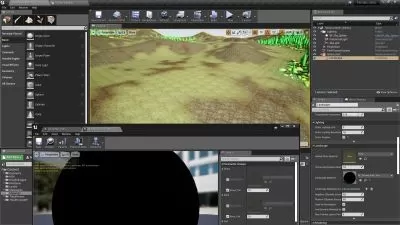Version Control Perforce using Unreal Engine 5 & 4
4:15:17
Description
Never lose your progress, always have a BACKUP Mastering Perforce for Unreal Engine Development UE4 and UE5
What You'll Learn?
- How to Install Perforce (Helix Core) for Free
- How to create a solid Backup Server for Unreal Engine Projects
- Download and Install any Unreal Engine 5 or 4
- Using Source Control of UE5 and UE4
- Creating a repository
- Committing to the repository
- Reverting to previous versions of the project and rewriting commit history
- Prepare PERFORCE to UNREAL ENGINE
Who is this for?
What You Need to Know?
More details
DescriptionWhy Use Perforce with Unreal Engine?
Perforce provides the tools needed to manage large, complex projects, while Unreal Engine’s integration makes it accessible for game developers. From version control to team collaboration, this combination ensures that game development workflows remain smooth, organized, and scalable. Whether you’re developing a solo project or managing a large team, Perforce ensures that your Unreal Engine projects remain secure and easy to manage across their entire lifecycle.
Perforce (Helix Core) is a leading version control system widely used in game development, especially for managing large assets and complex projects. Unreal Engine, one of the most popular game development platforms, seamlessly integrates with Perforce, making it easier for teams to collaborate and manage project files efficiently.
Key Benefits of Using Perforce with Unreal Engine:
Efficient Large File Handling: Unreal projects often contain large binary files, like textures, models, and audio assets. Perforce is optimized for handling these large files, ensuring fast and reliable storage and access.
Asset Locking for Collaboration: With multiple developers working on the same Unreal Engine project, asset conflicts can be common. Perforce's file locking feature prevents team members from overwriting each other’s work by locking assets when someone is working on them.
Comprehensive Version Tracking: Perforce tracks every change made to project files, including who made the changes and when. This ensures a detailed history, making it easier to revert to previous versions or audit changes.
Branching and Merging: For large projects or teams, branching and merging are essential for testing new features, bug fixing, or working on different parts of the project simultaneously. Perforce’s robust branching and merging capabilities make it ideal for complex Unreal Engine projects.
Seamless Integration with Unreal Engine: Unreal Engine natively supports Perforce, allowing for an easy setup. Developers can connect their Unreal projects directly to a Perforce repository, enabling smooth version control without leaving the Unreal Engine environment.
Collaboration Across Teams: Whether working in a small or large team, Perforce enables efficient collaboration. Multiple team members can work on different aspects of the project simultaneously, all while ensuring the integrity of the project files and avoiding conflicts.
Throughout the course, you'll explore the fundamental concepts of Perforce, including setting up a Perforce server, managing repositories, and dealing with common challenges in game development. You'll also get hands-on experience working with Unreal Engine’s specific version control features UE5 and UE4, ensuring that your projects are well-organized, secure, and easy to scale as they grow.
By the end of this course, you'll have a strong understanding of how to use Perforce to effectively manage Unreal Engine projects, collaborate with teams, and ensure smooth development pipelines, making you a more efficient and organized game developer.
Who this course is for:
- Any artist, programmer, game developer using Unreal Engine 5 or UE4
- Users learning Unreal Engine
- Freelancers and Professionals that need to have a Backup solution for Free
- Game developers
Why Use Perforce with Unreal Engine?
Perforce provides the tools needed to manage large, complex projects, while Unreal Engine’s integration makes it accessible for game developers. From version control to team collaboration, this combination ensures that game development workflows remain smooth, organized, and scalable. Whether you’re developing a solo project or managing a large team, Perforce ensures that your Unreal Engine projects remain secure and easy to manage across their entire lifecycle.
Perforce (Helix Core) is a leading version control system widely used in game development, especially for managing large assets and complex projects. Unreal Engine, one of the most popular game development platforms, seamlessly integrates with Perforce, making it easier for teams to collaborate and manage project files efficiently.
Key Benefits of Using Perforce with Unreal Engine:
Efficient Large File Handling: Unreal projects often contain large binary files, like textures, models, and audio assets. Perforce is optimized for handling these large files, ensuring fast and reliable storage and access.
Asset Locking for Collaboration: With multiple developers working on the same Unreal Engine project, asset conflicts can be common. Perforce's file locking feature prevents team members from overwriting each other’s work by locking assets when someone is working on them.
Comprehensive Version Tracking: Perforce tracks every change made to project files, including who made the changes and when. This ensures a detailed history, making it easier to revert to previous versions or audit changes.
Branching and Merging: For large projects or teams, branching and merging are essential for testing new features, bug fixing, or working on different parts of the project simultaneously. Perforce’s robust branching and merging capabilities make it ideal for complex Unreal Engine projects.
Seamless Integration with Unreal Engine: Unreal Engine natively supports Perforce, allowing for an easy setup. Developers can connect their Unreal projects directly to a Perforce repository, enabling smooth version control without leaving the Unreal Engine environment.
Collaboration Across Teams: Whether working in a small or large team, Perforce enables efficient collaboration. Multiple team members can work on different aspects of the project simultaneously, all while ensuring the integrity of the project files and avoiding conflicts.
Throughout the course, you'll explore the fundamental concepts of Perforce, including setting up a Perforce server, managing repositories, and dealing with common challenges in game development. You'll also get hands-on experience working with Unreal Engine’s specific version control features UE5 and UE4, ensuring that your projects are well-organized, secure, and easy to scale as they grow.
By the end of this course, you'll have a strong understanding of how to use Perforce to effectively manage Unreal Engine projects, collaborate with teams, and ensure smooth development pipelines, making you a more efficient and organized game developer.
Who this course is for:
- Any artist, programmer, game developer using Unreal Engine 5 or UE4
- Users learning Unreal Engine
- Freelancers and Professionals that need to have a Backup solution for Free
- Game developers
User Reviews
Rating

Udemy
View courses Udemy- language english
- Training sessions 58
- duration 4:15:17
- Release Date 2025/01/16









